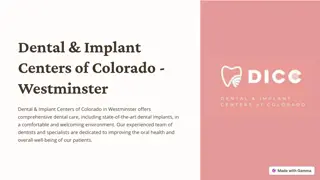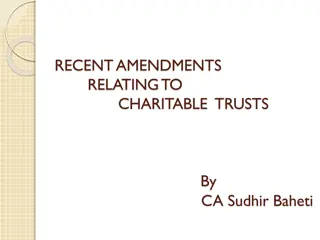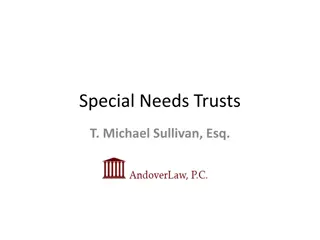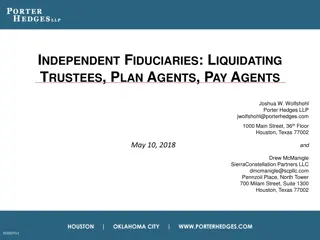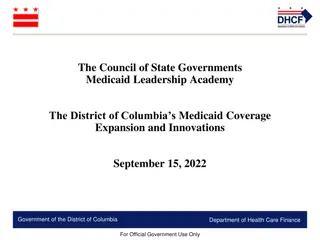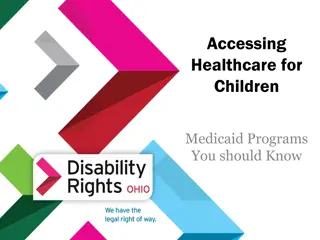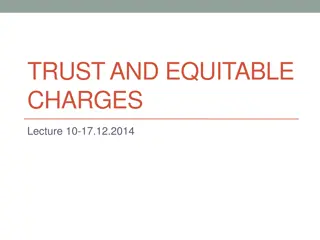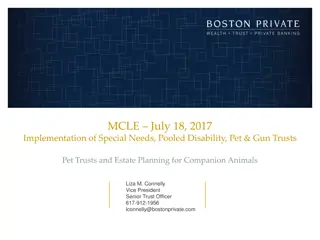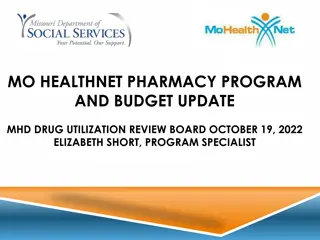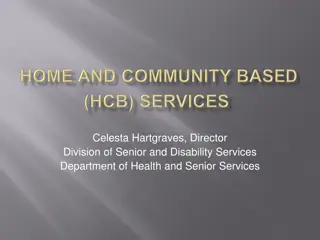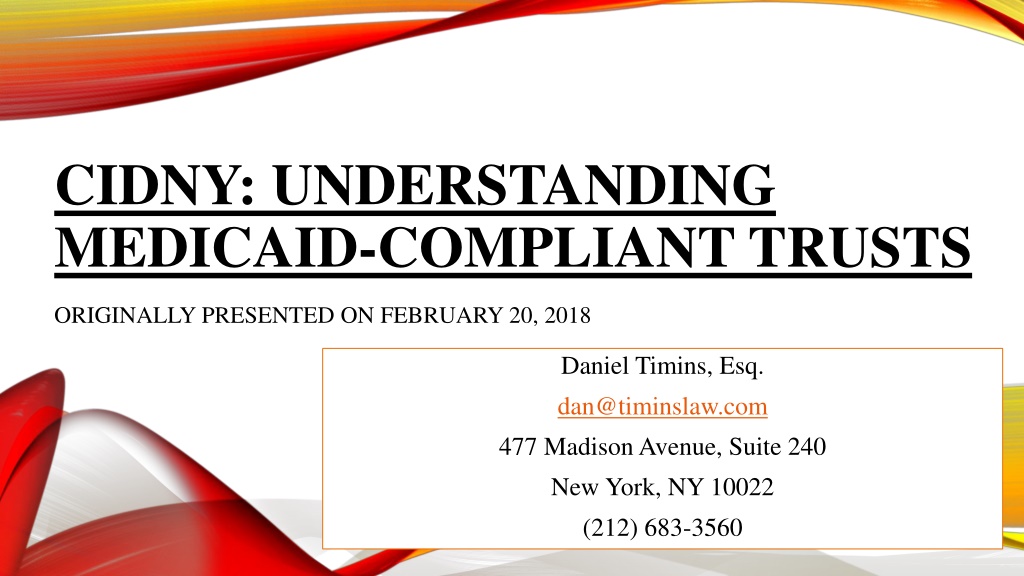
Understanding Medicaid-Compliant Trusts and Social Security Disability Programs
Learn about Medicaid-compliant trusts and Social Security Disability programs, including SSI and SSDI, entitlement vs. needs-based government programs, types of Social Security, and more in this detailed presentation by Daniel Timins, Esq.
Download Presentation

Please find below an Image/Link to download the presentation.
The content on the website is provided AS IS for your information and personal use only. It may not be sold, licensed, or shared on other websites without obtaining consent from the author. Download presentation by click this link. If you encounter any issues during the download, it is possible that the publisher has removed the file from their server.
E N D
Presentation Transcript
CIDNY: UNDERSTANDING MEDICAID-COMPLIANT TRUSTS ORIGINALLY PRESENTED ON FEBRUARY 20, 2018 Daniel Timins, Esq. dan@timinslaw.com 477 Madison Avenue, Suite 240 New York, NY 10022 (212) 683-3560
WHAT ARE WE TALKING ABOUT? What is SSI? What is Medicaid? Who are we talking about? Types of Medicaid Trusts Focus on Trust Investments
ENTITLEMENT V. NEEDS BASED GOVERNMENT PROGRAMS Entitlement Programs you paid for it, you get it Separately withdrawn from your paycheck: 15.3% You pay half, your employer pays half 6.20% for Social Security, 1.45% for Medicare You must pay in for 40 working quarters SSDI and MEDICARE: SSI and MEDICAID: Needs Based Programs (1) Must have the physical / mental need (2) Means Tested : must meet asset & income limits Comes out of your general income tax dollars You did not pay for it for 40+ quarters RESTRICTIONS APPLY: That s why we use Trusts (to minimize restrictions)
(SOME) TYPES OF SOCIAL SECURITY Social Security (Retirement) Disability Income Retired & Ages 62 + Disabled (Ages < 65) 40+ Quarters 40+ Quarters Social Security Supplemental Security Income Disabled < 40 Quarters (sometimes not at all) Disabled 19 year old with autism Disabled 68 year old who never worked 40 quarters Disability required AND NOT worked 40+ quarters Varies based on your needs Yes: Some MUST be spent on food & housing Who receives it? How long have they paid Social Sec? Examples Healthy retired grandparent Disabled person now older than 64 who was on SSDI Disability NOT required Varies based on contributions No spend however you want Disabled long-time worker The BIG Concept Disability required AND worked 40+ quarters Varies based on contributions No spend however you want How much do you receive? Limits on Use?
5 SOCIAL SECURITY DISABILITY There are 2 types of Social Security Disability programs: SSDI: Social Security Disability Income SSI: Supplemental Security Income These programs provide $ MONEY $ These are NOT Social Security Retirement SSDI eventually reverts to SS Retirement SSI does NOT (usually)
6 SSI LIMITED DISABILITY Paid into SS for LESS than 40 quarters Max Benefit: $857 / month in 2018 Fed max is $750, NY max is $87 Benefit based on living arrangement & other income Limitations: Assets of only $2,000 Excess must be held in Supplemental Needs Trust Spending Requirements MUST spend some of the money on Food & Clothing Automatic Medicaid eligibility
7 SSDI FULL DISABILITY Paid into SS for 40 fiscal quarters Max Benefit: $2,788 in 2018 Benefit base on income history No limit on how much assets you have Income limits do apply: No limit on passive income You can still earn < $1,170 / month in income No government requirements how it must be spent TIP: If you are nearing 40 quarters, try to keep working before applying: SSDI has more freedom than SSI (20 of those quarters must be in past 10 years)
MEDICARE 8 A HEALTH care program: 40 quarter qualification you can qualify for Medicare 2 years after you are declared disabled (which takes 5 months) Parts PART A: Inpatient Hospital Care Eligible people pay during working years; pay up to $407 per month if Ineligible PART B: Supplemental Medical Insurance Pay $104.90 - $335.70 per month PART C: Managed Care Cost varies by plan PART D: Prescription Drug Benefits $0-$50 per month; cost varies by plan; higher income consumers often pay more
WHAT IS MEDICAID? Medicaid is: (1) a healthcare program (2) that assists low-income families or individuals (3) in paying for long-term medical and custodial care costs (4) a joint program, funded primarily by the federal government (5) and run at the state and county level (6) where coverage, exemptions and costs may vary.
BUT WHAT IS MEDICAID?!!? PAYS FOR HEALTH CARE Pays for care regarding ACTIVITIES OF DAILY LIVING ( ADLs ) Transferring (Walking) Bathing Dressing Eating Continence Toileting Pays health care providers Payor of last result Picks up Medicare deductibles and co-pays, but still must pay Medicare Part B
MEDICAID V. MEDICARE Medicaid Resource Limits Assets: $15,150 Income: $842 Spouse s resources can limit / be limited for Medicaid Assets: $74,820 $123,600 Income: $3,090 Look Back on transfers Home Care 1 month Nursing Home 5 years Exemptions permitted (Ex: trusts, spousal refusal, promissory notes) Medicare No Resource Limits Spousal resources immaterial No need to transfer Exemptions unnecessary
WHO ARE WE TALKING ABOUT? Medicaid for the DISABLED not people under Affordable Care Act Children born disabled (who will remain disabled) People who were not born disabled (who became disabled) People who are not disabled (who MAY become disabled) Can also be for people who are disabled and shall one day no longer be disabled, but this can be tricky. Medicaid & other programs may have to be paid back. Pay back begins at 55 years old But MUST pay back all nursing home care at any age
TYPES OF MEDICAID TRUSTS Supplemental Needs Trust 3rd Party Trusts Inter Vivos Trusts (created during life) Testamentary Trusts (created by a Will) 1st Party Trusts Medicaid Asset Trusts / Income Only Trusts Pooled Income Trusts
MEDICAID TRUST COMPARISONS SNT 1st Party Bene, parent, g.p., guardian, court Bene s Assets & Income Post disability SNT 3rd Party NOT beneficiary Income Only Trust Beneficiary(ies) Pooled Trust Bene, Power of Atty Bene s Income Who creates it? What does it protect? Donor s Assets Bene s Assets Pre or Post Disability? Pre or Post disability Pre disability Post disability Who gives money to the trust? Beneficiary Not Beneficiary Beneficiary(ies) Beneficiary(ies) Transfers $ left-overs @ death? No Yes Yes No
15 SNTS: 1ST PARTY V. 3RD PARTY 1st Party SNT The beneficiary s money Any remaining money first goes to pay back the government Created with help of a parent, grandparent, guardian or court order 3rd Party SNT A 3rdParty s money NEVER the beneficiary s money Remaining money goes where creator decides Anyone can create for someone else Can be creates by a Will (a testamentary trust )
1ST PARTY SNTS: MEDICAID RECIPIENT S MONEY Creator Beneficiary, Parent, Grandparent, Guardian, Court Order Beneficiary 1. Medicaid Recipient 2. Medicaid Pay Back 3. Heirs / Next of Kin Trustee Anyone Except Bene / Medicaid Recipient
SUPPLEMENTAL NEEDS TRUSTS: 1ST PARTY What Is It? A trust that holds beneficiary s excess assets (but can hold assets from outside parties) Who Usually Uses Them? Currently disabled people who have too much money in their name to qualify for Medicaid Special Features, Facts & Functions? You can name your own trustee (unlike Pooled Income Trusts) Excess funds can be invested Pay back to Medicaid applies Requires acceptance by Human Resource Administration; they don t like them Best Way to Fund It? With YOUR money (since there is a pay-back provision, don t want to fund it with other people s money)
3RD PARTY SNTS: NON-MEDICAID RECIPIENT S MONEY Creator Anyone Except Bene / Medicaid Recipient Beneficiary Trustee 1. Medicaid Recipient 2. Remainder to anyone else Anyone Except Bene / Medicaid Recipient
SUPPLEMENTAL NEEDS TRUSTS: 3RD PARTY What Is It? An SNT created with OTHER people s money ONLY This is why it is a 3rd party trust (I.e. a 3rdparty s money, not the Medicaid beneficiary s) Who Usually Uses Them? Parents, grandparents, siblings, friends who want to help disabled beneficiaries Special Features, Facts & Functions? Can be created by anyone other than the beneficiary May be made by Will ( testamentary ) or stand-alone Trust ( inter vivios ) Left over money goes to the trust s choice of future beneficiaries, NO pay-back Medicaid Best Way to Fund It? ONLY other people s money because there is no pay-back 1st party money is disallowed Some liquidity, other assets that don t generate large income taxes
INCOME ONLY TRUSTS: MEDICAID RECIPIENT S MONEY Creator The Bene / Future Medicaid Recipient Beneficiary Trustee 1. Medicaid Recipient (income ONLY) 2. Creator s choice of future Beneficiary Anyone Except Bene / Medicaid Recipient (typically their child)
INCOME ONLY TRUSTS What Is It? A trust that ONLY allows income to be distributed (so it protects trust ASSETS) Who Usually Uses Them? Aging individuals who MAY get disabled OR people recently diagnosed with progressive illnesses Have modest assets who want to protect what they have Willing to accept Medicaid-level care in the future Special Features, Facts & Functions? Only income is distributable to Creator beneficiary Leaves remaining trust asset to children Best Way to Fund It? Primary residence Asset protect with no need to distribute income Still gets step-up in basis at death Creator beneficiary still get favorable real estate tax exemptions ( STAR ) Using assets that Creator beneficiary only requires income from
POOLED INCOME TRUST: MEDICAID RECIPIENT S MONEY Creator Beneficiary, Bene s POA Beneficiary Trustee 1. Medicaid Recipient 2. Not-For-Profit gets remainder Not-For-Profit agency
POOLED INCOME TRUSTS What Is It? An SNT created by a Not For Profit [ NFP ] who is also the Trustee Accepts lump sums & Medicaid recipient s spend down income Beneficiary (or POA) forward bills to NFP / NFP pays qualified bills Who Usually Uses Them? People on Medicaid with too much income to qualify (I.e high spend-downs) People of any age (but increasingly for the elderly) Special Features, Facts & Functions? NFP keeps remaining funds when the beneficiary dies SO spend this money BEFORE you spend money from a 3rd party trusts Best Way to Fund It? Deposit excess income to this trust, NOT assets, because the NFP receives left-over money NO CHOICE regarding investments only cash is in the trust
SCENARIO 1 UTMA from parent to now-adult child ($28,000)--do funds need to be transferred to trust or can it just pay bills directly? REMEMBER: We are dealing with Medicaid! What are the issues? What types of trust(s) should you use? HINT: An UTMA becomes property of a beneficiary at 21
SCENARIO 2 Medical malpractice settlement proceeds ($100,000) REMEMBER: We are dealing with Medicaid! What are the issues? What types of trust(s) should you use?
SCENARIO 3 Grandmother wants to leave a small inheritance($30,000) REMEMBER: We are dealing with Medicaid! What are the issues? What types of trust(s) should you use? HINT: grandma is still alive
SCENARIO 4 Personal savings ($50,000) REMEMBER: We are dealing with Medicaid! What are the issues? What types of trust(s) should you use?
SCENARIO 5 Pension income of individual in need of Medicaid ($1,400/mo.) REMEMBER: We are dealing with Medicaid! What are the issues? What types of trust(s) should you use? HINT: This is an income issue
TEST QUESTION 1 For which program can there be a look-back on transfers? a. Medicare b. Medicaid c. Both Medicare and Medicaid d. Neither Medicare nor Medicaid
TEST QUESTION 2 Into which trusts ca a beneficiary's excess income be transferred? (Circle all that apply.) a. 1st party SNT b. 3rd party SNT c. Income-only Trust d. Pooled Income Trust
TEST QUESTION 3 Which kind of trust can be established for a client over the age of 65? (Circle all that apply.) a. 1st party SNT b. 3rd party SNT c. Income-only Trust d. Pooled Income Trust
TEST QUESTION 4 Who receives "leftover" assets in a Pooled Income Trust after a beneficiary passes away? a. To the beneficiary listed on the trust document. b. To the beneficiary listed in the individual's last will and testament. c. To the government. d. To the not-for-profit running the PIT



